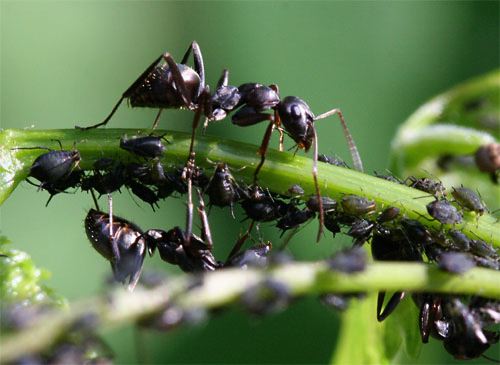
http://www.hiltonpond.org/ThisWeek070701.html
Introduction
Aphids are distributed worldwide, but mainly in temperate zones. They produce asexually; females can produce up to 12 offspring a day. These populations sometimes have the ability to increase rapidly. In good conditions, newborns can develop into reproducing adults in less than two weeks. [1] Ants are well-known protectors of aphids. They feed off of honeydew they produce, and in return, protect them from parasites and other predators. [2]
Description of Relationship
Aphids are of the superfamily Aphidoidea. They feed on phloem sap, which is high in sugar but low in nitrogen. This requires them to ingest high amounts of the phloem sap, which in turn causes them to excrete a substance called honeydew through their anus. This substance is very sweet, containing excess sugar from their diet. Not all ants have relationships with aphids, but some ants feed off of this substance. Worker ants of subfamilies Formicinae and Dolichoderinae, along with some species in genus Myrmica and Tetramorium collect the honeydew. [5] They provide protection for the aphids by protecting eggs during the winter, and transporting newborns to host plants. Here, the newborn aphids feed on the plant leaves, providing honeydew excretions for the ants. [3] Ants really take care of the aphids, leading them to new food sources when needed, and defending them in the case of predators.
Sometimes, ants will even stimulate the aphids by using their antennae to stroke them, encouraging them to produce the honeydew. This can cause aphids to lose the ability to release waste on their own, making them dependent on the ants for this reason.
However, as with any mutualistic relationship, ants really are looking out for themselves. They protect the aphids only because they need the honeydew. For example, while aphids are usually wingless, they are sometimes able to produce wings. If needed, they can fly away from poor environmental conditions, or find new food sources. Because ants do not want the aphids to leave, they have sometimes gone to extreme measures to keep the aphids around. They release chemicals to prevent wing development, or in worse situations, even destroy the already-developed wings. [2]
It has been indicated that these associations were in existence as far back as the early Oligocene. The prevalence of ant relationships does not seem to change among different groups of aphids. [5]
This relationship is an example of mutualism. Mutualism is defined as a relationship between two species who associate with each other so that each benefits. Instead of one partner exploiting the other without reciprocity, each partner exploits the other. In this relationship, the ants exploit the aphids in order to receive the honeydew, and the aphids use the ants as a means for protection they could not provide themselves. [4]
Cost/Benefit Analysis
Aphids
Cost: Aphids can be damaged by ants trying to destroy their wings, and also can become dependent on ants for excretion of honeydew. [2] By increasing intake of honeydew in order to attract ants, aphids reduce efficiency and therefore reduce growth rate. [5]
Benefit: protection from parasites and other natural enemies [5]
Ants
Cost: Morphological/behavioral adaptations necessary to collect and transport honeydew to nest mates. Another cost is dependence on aphids for fuel.
Benefit: Getting honeydew from aphids - food source [5]
http://www.youtube.com/watch?v=Dhi-SYxNPFw
References
[1] http://www.uri.edu/ce/factsheets/sheets/aphids.html
[2] http://insects.about.com/od/coolandunusualinsects/f/antsandaphids.htm
[3] http://science.jrank.org/pages/462/Aphids-Ants-aphids.html
[4] http://www.jstor.org/stable/2647385
[5] http://www.annualreviews.org/doi/full/10.1146/annurev.ecolsys.36.091704.175531
Does the interaction between the ant and asphid have an effect on the fitness of the asphid since it uses much of its energy creating honeydew for the ant to consume? Also, is there any reason to your knowledge why natural selection has not selected for asphids to no longer grow wings or to be able to regenerate wings (as some animals are able to re-grow certain limbs and extremities), which would prevent the ant from to destroying the asphid for its own benefit?
ReplyDeleteThis comment has been removed by the author.
ReplyDeleteThis comment has been removed by the author.
ReplyDelete